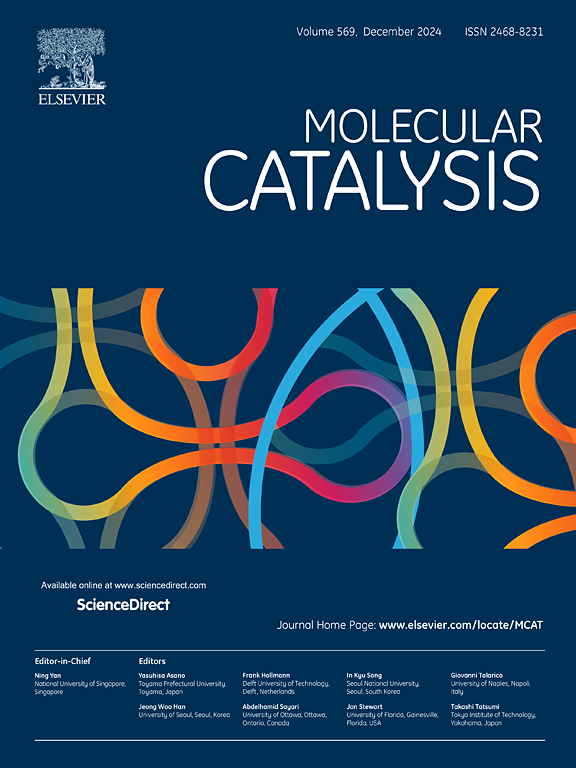提高乙酰丙酸加氢制γ-戊内酯催化稳定性的镍烯制定碳催化剂
IF 3.9
2区 化学
Q2 CHEMISTRY, PHYSICAL
引用次数: 0
摘要
在这项研究中,我们证明了在镍(Ni@NC)上应用氮掺杂碳涂层可以提高其通过加氢将乙酰丙酸(LA)转化为γ-戊内酯(GVL)的耐久性。各种表征技术表明,碳结构是多孔的,由于镍和碳框架之间的强相互作用,镍被高度分散和嵌入。在200 ~ 260℃的常压下,以不同的重量时空速(WHSV)值对LA加氢进行了催化试验。结果表明,Ni@NC催化剂在240℃、WHSV为1.14 h-1的条件下,LA转化率为88%,GVL选择性为100%。该催化剂在260℃和常压下,在2.28 h-1的WHSV条件下,维持了100小时的高GVL产率和优异的长期稳定性。而采用浸渍法制备的Ni/g-C3N4催化剂在相同条件下,GVL产率较高,但稳定性较差。这些发现表明,具有强金属-载体相互作用的催化剂可以潜在地提高稳定性。本文章由计算机程序翻译,如有差异,请以英文原文为准。

Ni-enacapulated carbon catalyst with enhanced catalytic stability for hydrogenation of levulinic acid to γ-valerolactone
In this study, we demonstrate that applying a nitrogen-doped carbon coating to nickel (Ni@NC) improves its durability for converting levulinic acid (LA) into γ-valerolactone (GVL) through hydrogenation. Various characterization techniques revealed that the carbon structure is porous, with nickel being highly dispersed and embedded due to a strong interaction between the nickel and carbon framework. Catalytic tests for LA hydrogenation were conducted at temperatures ranging from 200 to 260 °C under atmospheric pressure, with different weight hourly space velocity (WHSV) values. The Ni@NC catalyst was found to be optimal, achieving 88% conversion of LA and 100% selectivity for GVL at 240 °C with a WHSV of 1.14 h-1. This catalyst maintained a high GVL yield and excellent long-term stability for 100 hours under conditions of WHSV of 2.28 h-1 at 260 °C and atmospheric pressure. In contrast, the Ni/g-C3N4 catalyst, prepared using the impregnation method, produced a good GVL yield but exhibited poor stability under the same conditions. These findings suggest that catalysts with strong metal-support interactions can potentially improve stability.
求助全文
通过发布文献求助,成功后即可免费获取论文全文。
去求助
来源期刊

Molecular Catalysis
Chemical Engineering-Process Chemistry and Technology
CiteScore
6.90
自引率
10.90%
发文量
700
审稿时长
40 days
期刊介绍:
Molecular Catalysis publishes full papers that are original, rigorous, and scholarly contributions examining the molecular and atomic aspects of catalytic activation and reaction mechanisms. The fields covered are:
Heterogeneous catalysis including immobilized molecular catalysts
Homogeneous catalysis including organocatalysis, organometallic catalysis and biocatalysis
Photo- and electrochemistry
Theoretical aspects of catalysis analyzed by computational methods
 求助内容:
求助内容: 应助结果提醒方式:
应助结果提醒方式:


